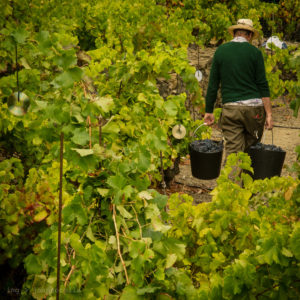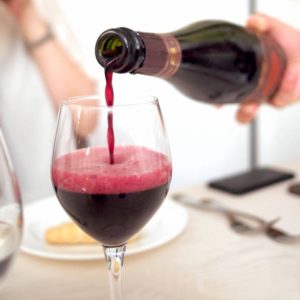Anyone remotely paying attention to wine these days has probably noticed an upward tick in alcohol concentrations. While it would be easy to simply blame a changing climate on this increase, there is evidence to suggest that these increases are not due to this factor alone. In fact, there could be many other “man-made” explanations – from the ability to get the ripest fruit possible to the most likely candidate, consumer demand. More recently, however, the demand for lower alcohol or dealcoholized wines has increased, for health or other reasons, leading to some winemakers performing dealcoholization steps to reduce the overall alcohol content, or otherwise adjust their vineyard and winery management practices to keep alcohol levels at a minimum.
Unfortunately, simply removing some (or all) of the alcohol in a wine can have major impacts on the chemical and sensory characteristics of the finished wine. Certainly, removing the alcohol will change some of the sensory character, however the process by which some physically remove the alcohol can also damage or remove other important sensory compounds in a wine, leaving you with a totally different wine at the end than what would have been had the alcohol remained.
One way to create a wine with lower alcohol is to simply harvest the grapes earlier. Of course, there are drawbacks to this as well, as other compounds in the grapes may not be at their ideal concentrations to produce a wine with the desired sensory profile, so while there may not be as much alcohol in the finished wine, the sensory profile may also be different.

Photo courtesy Flickr user Joan Sorolla
So, if a winemaker wants to make a wine with lower alcohol, should she/he harvest the grapes early? Or harvest the grape at the “usual” time and simply remove the alcohol later. With negative implications for both options, it’s important to have a deeper understanding of what is going on from both a chemical and sensory perspective.
There are many approaches to removing alcohol in wines, though the purpose of this post is not to do a general comparison of all of them. Two of the more common approaches include evaporative perstraction, which has been shown to decrease fruity esters in the finished wine, and a membrane-based system utilizing reverse osmosis. A new study, available online now and to be published in the September 2018 issue of the journal Food Chemistry, aimed to compare one dealcoholization approach to early harvest of grapes, to gain a better understanding of the chemical and sensory changes made by the two approaches.
Brief Methods
Verdelho and Petit Verdot grapes were utilized in this study and were grown in the Mudgee region of New South Wales, Australia (2016 harvest).
180kg of fruit was harvested at each designated harvest time.
Early harvest occurred when total soluble solids were 17.2 +/- 0.5 oBrix for Verdelho and 21.4 +/-0.4 oBrix for Petit Verdot.
The later harvest occurred when total soluble solids were 23.3 +/- 0.3 oBrix for Verdelho and 23.6 +/- 0.5 oBrix for Petit Verdot.
Dealcoholization occurred in triplicate for the later harvested grapes 11 weeks after bottling, and utilized reverse osmosis followed by a membrane contactor. 4.5% alcohol by volume was removed from Verdelho wines, while 2.5% alcohol by volume was removed from Petit Verdot wines.
(Three treatments: early harvest, later harvest, and dealcoholized later harvest).
Chemical analyses were performed on the juice samples after harvest, as well as the wine samples immediately after bottling.
Sensory analysis was performed by a trained panel of 13 individuals (5 women, 8 men; aged 25 to 55). Panelists rated each sensory descriptor using an unstructured line scale (characteristic absent –> intense).
Selected Results
- TA, pH, glucose, fructose, malic acid, and acetic acid did not change with wine dealcoholization.
Dealcoholized wines versus later harvest wines:
- Ethyl esters were significantly reduced in dealcoholized wines compared with later harvest wines.
- Percentage lost were between 38% and 87% and were more significant for Verdelho wines than Petit Verdot.
- The ethyl esters that decreased the most were ethyl hexanoate (70% loss), ethyl decanoate (82% loss), and ethyl dodecanoate (83% loss).
- Ethyl cinnamate and ethyl dihydrocinnamate decreased in dealcoholized Petit Verdot wines by 55% and 44%, respectively.
- Ethyl octanoate, ethyl decanoate, and ethyl leucate were not significantly reduced in dealcoholized Verdelho wines.
- Isoamyl acetate decreased up to 72% in dealcoholized Verdelho wines, though were not significantly reduced in dealcoholized Petit Verdot wines.
- 1-hexanol decreased by 40% and 25% in dealcoholized Verdelho and Petit Verdot wines, respectively.
- 1-hexanol was the only alcohol showing decreases in dealcoholized Verdelho wines, while all C6-alcohols (minus cis-3-hexanol) decreased from 25 to 53% in dealcoholized Petit Verdot wines.
- γ-nonalactone decreased up to 30% in dealcoholized Petit Verdot wines, while it did not significantly change in dealcoholized Verdelho wines.
- Terpenoids decreased up to 94% in dealcoholized Verdelho wines, with β-citronellol seeing the biggest drop. Unchanged terpenoids included trans-geraniol, 1,4-cineole, and α-terpinene.
- The only terpenoids with significant decreases in dealcoholized Petit Verdot wines were β-citronellol (68%), 4-terpineol (3.5%), and α-terpineol (64%).

Photo courtesy Pixabay
Dealcoholized wines versus early harvest wines:
- Ethyl ester concentrations were higher in early harvest Verdelho wines compared with dealcoholized wines.
- Lactone and monoterpene concentrations were lower in early harvest Verdelho wines compared with dealcoholized wines.
- Ethyl ester concentrations were higher in early harvest Petit Verdot wines compared with dealcoholized wines.
- C6-alcohols, acetates, and C13-norisoprenoids were not significantly changed between early harvest and dealcoholized Verdelho wines.
- C6-alcohols, lactone, and monoterpene concentrations were higher in early harvest Petit Verdot wines compared with dealcoholized wines.
- C13-norisoprenoids were significantly lower in early harvest Petit Verdot wines compared with dealcoholized wines.
Sensory Analysis
- The biggest sensory differences were found between the early and later harvest wines.
- Buttery/nutty aromas were more intense in early harvest Verdelho wines compared with dealcoholized Verdelho wines.
- Tropical fruit, overall aroma intensity, bitterness, and perception of alcohol were less intense in dealcoholized Verdelho wines compared with later harvest Verdelho wines.
- Overall aroma intensity, astringency, and perception of alcohol were less intense in dealcoholized Petit Verdot wines compared with later harvest Petit Verdot wines.
- Red fruit aroma was higher in early harvest Petit Verdot wines compared to dealcoholized wines.
- Dark fruit aroma was lower in early harvest Petit Verdot wines compared to dealcoholized wines.
Conclusions
Overall, this study shows what most winemakers and wine experts already know—removing some of the alcohol in wine changes the chemical and sensory characteristics wines. Exactly how these changes are different depend upon the type of grape/wine, and what type of wine

Photo By CCFoodTravel.com – Flickr, CC BY 2.0
you’re comparing it to (early versus late harvest).
Interestingly, the biggest differences in sensory characteristics appeared to be between the early and late harvest wines, with the dealcoholized wines falling somewhere in between. When removing the alcohol, some of the sensory characteristics of the wine were lost, though the difference between dealcoholized later harvest wine and say a wine made from earlier harvested grapes wasn’t as much as early versus later harvest wines with the alcohol “intact”. I have to assume that the sensory panel preferred the aromas/flavors of the early and later harvest wines compared with the dealcoholized wines based on the decreases seen in aroma-contributing compounds, but alas, they did not actually test this so I can’t be sure. It would have been interesting to have them answer that simple question.
Overall, the data would suggest that the red Petit Verdot could “handle” the dealcoholization process better from a sensory perspective than the white Verdelho, though it’s not known whether this is true for all reds versus whites. It would be interesting to see a study utilizing more kinds of wines.
Finally, a study including multiple methods of removing the alcohol from wines would be interesting to compare (which may have already been done, I’ve just not looked for it yet).
With the recent consumer trend of seeking out lower alcohol wines, it may be of interest to winemakers to come up with their own strategy to create a line of wines that achieves just that, and hopefully studies like this one might help them choose exactly what viticultural or winemaking procedures to employ. Of course, this particular study shouldn’t be the only reference, as it’s implications are rather limited, though it is certainly a start.
Source:

1 comment for “Lowering the Alcohol Content of Wine: Comparison of Dealcoholization versus Early Harvest”